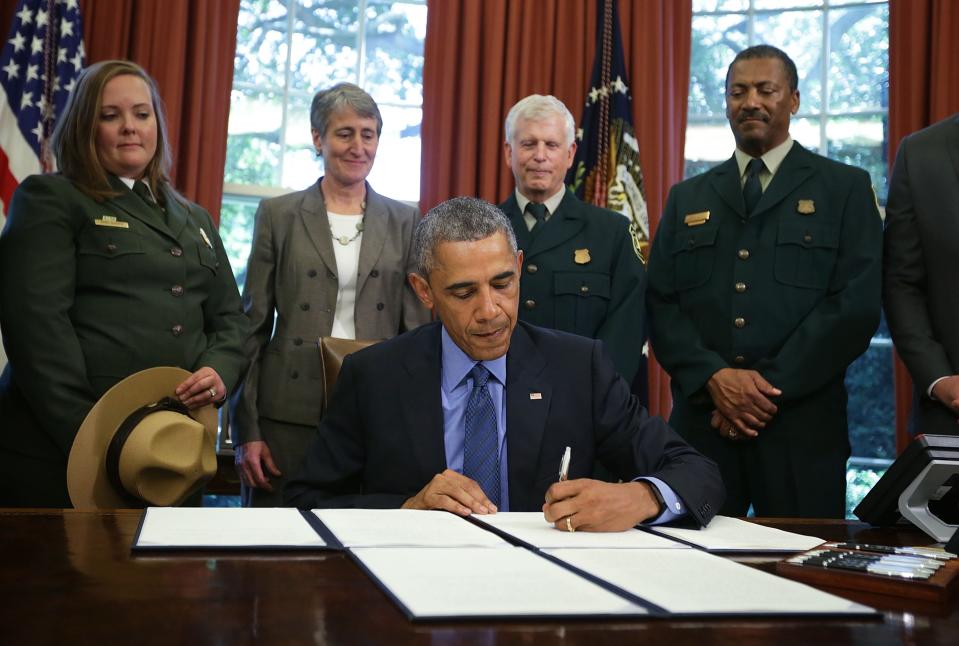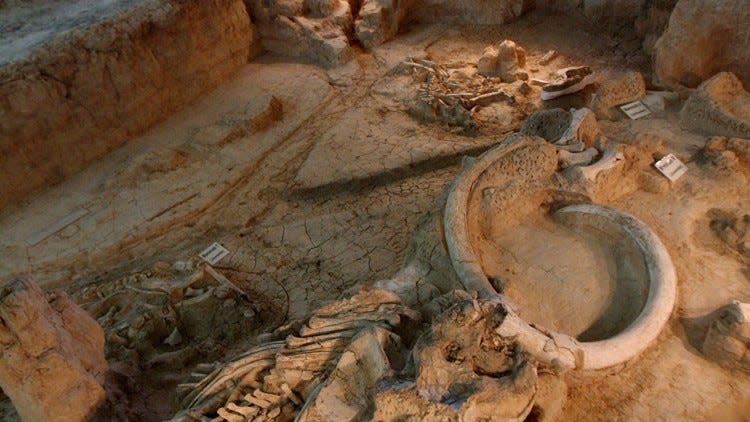One of the most amazing sites in Texas is in Waco and it's thousands of years old
WACO — The young Texans found something unusual in the ravine.
Something big.
Maybe it was a bone. Larger, however, than any bone they had ever seen.
That's because what Paul Barron and Eddie Bufkin discovered in 1978 while searching for snakes, arrowheads and fossils at a dairy farm just northwest of Waco was a fossilized leg bone of a Columbian mammoth.
Otherwise known as the imperial mammoth, these enormous, extinct mammals of southern North America could reach 14 feet high at the shoulder, taller than today's African elephants at 13 feet, and the Columbian's prehistoric cousins, Eurasian woolly mammoths, at 10 feet.
"It looked like human skull at first, and I thought we were in an old Indian burial ground," Barron later told the American-Statesman. "I dug it out with my hands. It was a solid sphere of bone, and I knew it had to be a ball and socket. ... The only thing I could think of that had a bone that big was an elephant."
More:When you go to Waco, and you should, visit these 10 tourist hotspots
The boys took the bone six miles away to Baylor University, where scientists identified the fossil. Luckily, the man who owned the dairy farm was a supporter of the university and encouraged a dig at the ravine. The exact site was kept secret for 35 years to prevent poaching.
The scientists jacketed the first bones that they found in plaster before storing them at what is now the Mayborn Museum Complex on the Baylor campus. Early finds remain in plaster to await further study.
Meanwhile, the dig continued. The scientists unearthed more mammoth remains, along with other fossils, such as at least one camel and a saber-tooth cat. The singular find, however, was an intact "nursing herd" of 16 to 19 female and juvenile mammoths that died together some 65,000 years ago.
"Very rarely do you find a whole animal," Anita Benedict, the collections manager at the Mayborn Museum Complex, told the American-Statesman in 2012. "What we have is a snapshot of an entire herd as opposed to an individual animal. ... Researchers believe they were trying to get in a protective circle around the younger animals, which is what modern elephants do."
Texas history, delivered to your inbox
Click to sign up for Think, Texas, a newsletter delivered every Tuesday
Now protected in a climate-controlled dig shelter, the site, run by the National Park Service, Baylor University, the city of Waco and the Waco Mammoth Foundation, is open to the public. It became a national monument in 2015.
It is just about the most amazing thing I've seen during the past few years of Texas road trips. Archeological and paleontological digs are inherently interesting to history and prehistory buffs. Yet to spend time at a dig where, just below the raised walkways, discoveries can be seen in places where they were found is mind-blowing.
Getting to the Waco mammoths
In last week's Think, Texas column about unexpected finds in historic downtown Waco, I trumpeted this national monument. Today, I dig a bit deeper.
My road-trip buddy and I left Austin at 8 a.m. on a Thursday. Although we dreaded the drive north on the usually congested Interstate 35, we found the 90-minute drive smooth and uninterrupted all the way to Waco.
We exited just before the northbound freeway crosses the Brazos River, took a left on Martin Luther King Jr. Boulevard, and followed the scenic road along the landscaped riverfront. MLK conveniently turns into Steinbeck Bend Drive and, within minutes, we spotted the familiar National Park Service sign — a decorated arrowhead shield next to a clearly designated name: "Waco Mammoth National Monument."
Personal peeve: Would that stewards of other Texas tourist spots used similarly clear signposts along busy, dangerous roads and highways.
More:Where the locals say to eat and drink in Waco
A short distance away waits the Welcome Center, where one can purchase tickets for guided or self-guided tours. (Federal park and recreation passes don't work here because of an agreement with local entities, who use the admission fees to maintain the site.) The center also serves as a gift shop and an outdoor display area where one can learn more about fossils.
We picked up a tour in progress as it headed down the wide and comfortably graded Mammoth Trail; two short hiking trails veer off from this main path through the wooded 100-acre site.
Before we reached the dig shelter, our excellent tour guide paused to tell the story of the 1978 fossil discovery before leading us across a bridge over a shallow ravine. She emphasized the vision of the original landowner, who not only gave scientists access to the site for 35 years, but also set the stage for the partnership among federal, city, university and nonprofit forces to acquire additional land for the larger footprint for this singular preserve.
The dig shelter feels something like a lighted, slightly chilly cavern. Our crowd of visitors remained quiet as the guide pointed out areas of interest and answered questions. We were invited to linger and, from the walkways, explore.
It is not an easy experience to absorb it all once.

Facts about these prehistoric finds in Waco
A total of 26 Columbian mammoths have been uncovered, including 16 — maybe as many as 19 according to another source — from a "nursing herd" of females and juveniles.
This was the first nursing herd of Columbian mammoths to have been discovered.
Experts are not sure why the nursing herd — as with modern elephants, males are kicked out when they reach maturity because they cause trouble — died all at once. The current theory is that they died during a flash flood in this low-lying ravine between the Bosque and Brazos rivers.
An alternative theory — which reflects another reality of Texas climate — is that they died during a long drought.
Previously, about 1.7 million years ago, mammoths crossed an ice bridge from Asia to North America; the Eurasian wooly mammoth and Columbian mammoth developed into different species.
The climate here during the Pleistocene Era was generally warm, not cold and icy as in the more northerly reaches of the continent.
Diggers here have found least one bull mammoth, another female and two juveniles that date from other periods; they died in at least two separate events.
While scientists are at work cloning Eurasian wooly mammoths, that feat would be more difficult with Columbian mammoths because the remains have not been preserved under ice. That leaves behind less flesh to scrape for genes to combine with a modern Asian elephant.
Columbian mammoths migrated as far south as Central America.
Herbivores, the mammoths mostly munched on grasses, twigs and fruits. Yet as a new glacial period started 50,000 years ago, they added cooler weather plants, including conifers, to their diets.
They ate from 300 to 700 pounds of food a day and drank 50 gallons of water a day.
With all that chewing, mammoths developed six sets of teeth during a lifetime.
Like modern elephants, Columbian mammoths were born with a trunk and tusks, which they used to dig for water and defend themselves. A male's tusk could be 10 to 16 feet long and weigh up to 200 pounds each.
An early camel died during the same event as the nursing herd. Camels actually first developed in North America; they are related to guanacos, llamas, alpacas and vicuñas, which headed south. Dromedaries and Bactrian camels headed north to Asia and beyond.
A saber-tooth cat died at this site in a later event.
Experts are pretty sure that humans were not involved in the mammoth deaths. The latest evidence from the Gault Site in the same watershed date the human presence in Central Texas to 20,000 years ago.
Columbian mammoths died out about 10,000 years ago, so they might have lived alongside humans here for 10,000 years, but the Waco fossils go back much further.
On July 10, 2015, President Barack Obama used his authority under the Antiquities Act to designate the site as Waco Mammoth National Monument.
You can see more mammoth bones up close in a replica of the Waco dig at Baylor University's Mayborn Museum Complex.
Michael Barnes writes about the people, places, culture and history of Austin and Texas. He can be reached at mbarnes@statesman.com. Sign up for the free, weekly Think, Texas digital newsletter at statesman.com/newsletters.

If you go to Waco
Waco Mammoth National Monument
Where: 6220 Steinbeck Bend Drive
When: 9 a.m.-5 p.m. daily, except Thanksgiving, Dec. 25 and Jan. 1
Cost: Up to $6. Tour fees are not covered by federal park or recreation passes.
Info: 254-750-7946; nps.gov/waco
This article originally appeared on Austin American-Statesman: A journey into prehistory at Waco Mammoth National Monument

